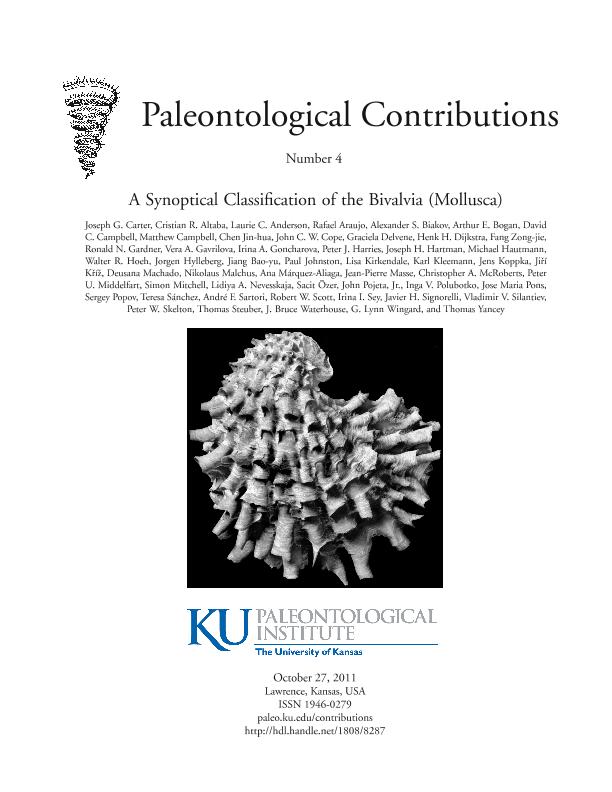Artículo
A Synoptical Classification of the Bivalvia (Mollusca)
Carter, Joseph G.; Altaba, Cristian R.; Anderson, Laurie C.; Araujo, Rafael; Biakov, Alexander S.; Bogan, Arthur E.; Campbell, David; Campbell, Matthew; Chen, Jin Hua; Cope, John C. W.; Delvene, Graciela; Dijkstra, Henk H.; Fang, Zong Jie; Gardner, Ronald N.; Gavrilova, Vera A.; Goncharova, Irina A.; Harries, Peter J.; Hartman, Joseph H.; Hautmann, Michael; Hoeh, Walter R.; Hylleberg, Jorgen; Jiang, Bao Yu; Johnston, Paul; Kirkendale, Lisa; Kleemann, Karl; Koppka, Jens; Kříž, Jiří; Machado, Deusana; Malchus, Nikolaus; Márquez Aliaga, Ana; Masse, Jean Pierre; McRoberts, Christopher A.; Middelfart, Peter U.; Mitchell, Simon; Nevesskaja, Lidiya A.; Özer, Sacit; Pojeta, John Jr.; Polubotko, Inga V.; Pons, Jose Maria; Popov, Sergey; Sanchez, Teresa Maria ; Sartori, André F.; Scott, Robert W.; Sey, Irina I.; Signorelli, Javier Hernan
; Sartori, André F.; Scott, Robert W.; Sey, Irina I.; Signorelli, Javier Hernan ; Silantiev, Vladimir V.; Skelton, Peter W.; Steuber, Thomas; Waterhouse, J. Bruce; Wingard, G. Lynn; Yancey, Thomas
; Silantiev, Vladimir V.; Skelton, Peter W.; Steuber, Thomas; Waterhouse, J. Bruce; Wingard, G. Lynn; Yancey, Thomas
 ; Sartori, André F.; Scott, Robert W.; Sey, Irina I.; Signorelli, Javier Hernan
; Sartori, André F.; Scott, Robert W.; Sey, Irina I.; Signorelli, Javier Hernan ; Silantiev, Vladimir V.; Skelton, Peter W.; Steuber, Thomas; Waterhouse, J. Bruce; Wingard, G. Lynn; Yancey, Thomas
; Silantiev, Vladimir V.; Skelton, Peter W.; Steuber, Thomas; Waterhouse, J. Bruce; Wingard, G. Lynn; Yancey, Thomas
Fecha de publicación:
10/2011
Editorial:
University of Kansas Press
Revista:
Paleontological Contributions
ISSN:
1946-0279
Idioma:
Inglés
Tipo de recurso:
Artículo publicado
Clasificación temática:
Resumen
The following classification summarizes the suprageneric taxono-my of the Bivalvia for the upcoming revision of the Bivalvia volumes of the Treatise on Invertebrate Paleontology, Part N. The development of this classification began with Carter (1990a), Campbell, Hoeks-tra, and Carter (1995, 1998), Campbell (2000, 2003), and Carter, Campbell, and Campbell (2000, 2006), who, with assistance from the United States National Science Foundation, conducted large-scale morphological phylogenetic analyses of mostly Paleozoic bivalves, as well as molecular phylogenetic analyses of living bivalves. Dur-ing the past several years, their initial phylogenetic framework has been revised and greatly expanded through collaboration with many students of bivalve biology and paleontology, many of whom are coauthors. During this process, all available sources of phylogenetic information, including molecular, anatomical, shell morphological, shell microstructural, bio- and paleobiogeographic as well as strati-graphic, have been integrated into the classification. The more recent sources of phylogenetic information include, but are not limited to, Carter (1990a), Malchus (1990), J. Schneider (1995, 1998a, 1998b, 2002), T. Waller (1998), Hautmann (1999, 2001a, 2001b), Giribet and Wheeler (2002), Giribet and Distel (2003), Dreyer, Steiner, and Harper (2003), Matsumoto (2003), Harper, Dreyer, and Steiner (2006), Kappner and Bieler (2006), Mikkelsen and others (2006), Neulinger and others (2006), Taylor and Glover (2006), Kříž (2007), B. Morton (2007), Taylor, Williams, and Glover (2007), Taylor and others (2007), Giribet (2008), and Kirkendale (2009). This work has also benefited from the nomenclator of bivalve families by Bouchet and Rocroi (2010) and its accompanying classification by Bieler, Carter, and Coan (2010).This classification strives to indicate the most likely phylogenetic position for each taxon. Uncertainty is indicated by a question mark before the name of the taxon. Many of the higher taxa continue to undergo major taxonomic revision. This is especially true for the superfamilies Sphaerioidea and Veneroidea, and the orders Pectinida and Unionida. Because of this state of flux, some parts of the clas-sification represent a compromise between opposing points of view. Placement of the Trigonioidoidea is especially problematic. This Mesozoic superfamily has traditionally been placed in the order Unionida, as a possible derivative of the superfamily Unionoidea (see Cox, 1952; Sha, 1992, 1993; Gu, 1998; Guo, 1998; Bieler, Carter, & Coan, 2010). However, Chen Jin-hua (2009) summarized evi-dence that Trigonioidoidea was derived instead from the superfamily Trigonioidea. Arguments for these alternatives appear equally strong, so we presently list the Trigonioidoidea, with question, under both the Trigoniida and Unionida, with the contents of the superfamily indicated under the Trigoniida.
Palabras clave:
Bivalvia
,
Taxonomy
,
Paleontology
,
Treatise
Archivos asociados
Licencia
Identificadores
Colecciones
Articulos(CCT-CENPAT)
Articulos de CTRO.CIENTIFICO TECNOL.CONICET - CENPAT
Articulos de CTRO.CIENTIFICO TECNOL.CONICET - CENPAT
Citación
Carter, Joseph G.; Altaba, Cristian R.; Anderson, Laurie C.; Araujo, Rafael; Biakov, Alexander S.; et al.; A Synoptical Classification of the Bivalvia (Mollusca); University of Kansas Press; Paleontological Contributions; 4; 10-2011; 1-47
Compartir
Altmétricas



